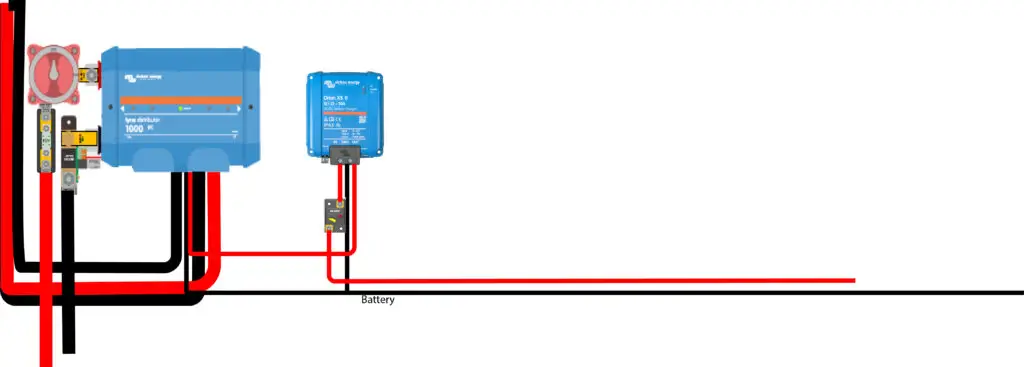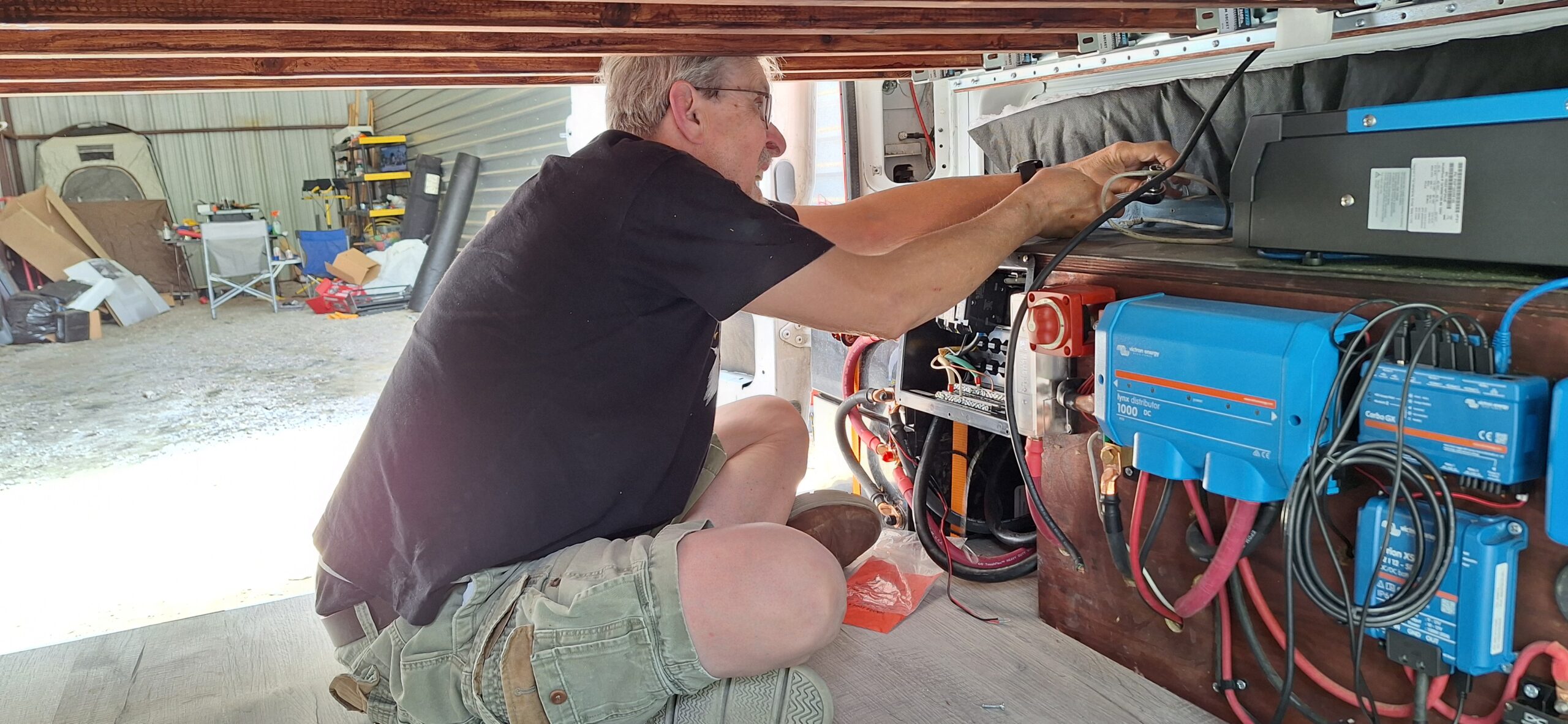All right, before we get going, here’s the deal. Your RV’s alternator is great at keeping the headlights on, but it’s not exactly a PhD when it comes to charging your house batteries, especially if you’re running lithium. That’s why you install a DC-to-DC converter. It takes the wild alternator output, cleans it up, and feeds your house bank the right stuff. Think of it like giving your batteries a balanced diet instead of gas station nachos.
I mean, I’ve tried the “just wire it straight to the alternator” approach. Spoiler alert, I also tried cutting my own hair once. Both ended with regret. I got a few.
Introduction
Installing a DC-to-DC converter in an RV improves charging performance while you drive. Obviously. The alternator isn’t designed to properly charge a house bank, especially LiFePO₄. A DC-to-DC charger regulates current between the chassis battery and the house bank so you get safe, consistent charging while the engine runs.
With models like the Victron Orion-Tr Smart 12/12-30A or Redarc BCDC1225D, you can set charge voltages, control current, and keep batteries from getting cooked. You’ll mount it, wire it, fuse it, ground it, and test it. Tools you’ll actually use: multimeter, crimper, heat gun, and a fuse block. Yes, you should crimp, not twist and pray.
Key Takeaways
- A DC-to-DC converter charges your house battery correctly while driving.
- Fuse both input and output. Protect the wires, protect your wallet.
- Pick a ventilated, dry, low-vibration spot to mount it.
- Match wire gauge to charger amps and cable length to avoid voltage drop.
- Test with a multimeter before you call it done.
- Bluetooth models or battery monitors make troubleshooting way easier.
- Ignition wiring matters if you have a smart alternator.
- Set the right battery profile. Double-check your lithium numbers.
- Secure and label everything with grommets, clamps, and heat shrink.
- Maintain it with voltage checks, firmware updates, and terminal inspections.
What Is a DC-to-DC Converter?
Relatable version: the alternator shoves power forward, the converter tells it to act right before it touches your house battery. In an RV with two batteries, that matters a lot.
Purpose in an RV Electrical System
It feeds the house bank the voltage and current it actually needs. That fixes smart alternator shenanigans, voltage drop over long runs, and chemistry-specific needs. You get proper charging instead of “maybe it’s fine.”
Common Voltage Configurations
| Input Voltage | Output Voltage | Application Example |
|---|---|---|
| 12V | 12V | Most common in camper vans |
| 24V | 12V | Step-down from heavy-duty alternator |
| 12V | 24V | Step-up for specialty equipment |
| 12V | Adjustable | Programmable for multi-bank setups |
Types of DC-to-DC Converters
| Type | Description |
|---|---|
| Isolated | Input and output grounds are separated to avoid ground loops |
| Non-Isolated | Common ground, simpler and cheaper |
| Dual Input | Alternator plus solar as charge sources |
| Programmable | Custom voltages for specific battery types |
Leading Brands and Models
- Victron Orion-Tr Smart 12/12-30A
- Redarc BCDC1225D
- Renogy 60A DC-DC
- Sterling BB1230
- CTEK D250SE
- PROFESSIONAL DC TO DC CHARGER: The Orion-Tr Smart DC-DC Charger is a professional charger that uses three stages to effi…
- DUAL BATTERY CHARGING: The Victron DC to DC charger is ideal for vehicles or boats where the alternator and start batter…
- BUILT-IN BLUETOOTH: The DC to DC charger can be monitored and cotrolled with smartphone or tablet via Bluetooth and the …

I’m sure a lot of you are going, “Do I really need the fancy one?” Different folks, different rigs. I like gear that tells me what it’s doing without me guessing.
Why You Need a DC-to-DC Converter in Your RV
Assumption: “My alternator charges everything.”
Reality: Not well, and not for lithium.
- Ensures Proper Charging of Lithium Batteries
Lithium wants specific voltages. Converters give you programmable profiles. If you wing it, your BMS will babysit you by shutting things down. - Bypasses Smart Alternator Limitations
Smart alternators drop voltage to save fuel. Converters stabilize it so charging actually happens. - Prevents Overloading the Alternator
They limit current draw so you don’t fry the alternator. Replacing an alternator on the road is a special kind of weekend. - Regulates Voltage Drop
Long cable runs steal volts. Converters compensate and keep the charge steady. - Enables Dual Input Charging
Some units take alternator plus solar. On sunny days, it’s like getting free pizza.
Tools and Parts You’ll Need
| Component | Use |
|---|---|
| Wire stripper | Removes insulation |
| Crimping tool | Attaches connectors |
| Multimeter | Verifies voltage |
| Heat gun | Shrinks tubing around terminals |
| Torque wrench | Prevents overtightening |
| DC-to-DC converter | Core device for voltage regulation |
| Inline fuse | Protects wires |
| Fuse block | Centralizes fuse connections |
| Ground wire | Ensures proper return path |
| Mounting bracket | Secures unit in place |
Now, before you ask, yes, you really do need a proper crimper. Pliers are not a personality.
Choosing the Right Location for Installation
Keep cable runs short and tidy, avoid heat and water, and give it 3 to 6 inches of airflow. Secure it with brackets and lock washers.
Common spots: under seats, utility bays, rear cabinets, bulkhead walls. If it’s damp or gets road spray, skip it.
Wiring the DC-to-DC Converter
Wiring Diagram

Imagine battery to fuse to converter to fuse to house battery, with a clean ground and a little ignition wire telling it when to wake up. If you draw it on a napkin, you’re 90 percent there.
Step-by-Step Wiring Instructions
- Connect to the Starter Battery (Input Side)
Run a positive input wire, something like 8 AWG for a 30A unit, from the starter battery or alternator output to the converter input.
Install an inline fuse or breaker within 7 inches of the starter battery.
Use ring terminals and heat shrink. Clean, tight, done. - Install the Ignition Trigger Wire
Many units, like the Victron Orion-Tr Smart, want a switched 12V source.
Tap the fuse box with an add-a-fuse.
Run it to the terminal labeled Remote or IGN.
This keeps the converter off when the engine is off, so you don’t nuke the starter battery. - Ground the Converter Properly
Ground to clean, bare metal using the same gauge as the positive cable.
Scrape off paint, use a toothed lock washer, and tighten it like you mean it. - Connect the Output to the House Battery
Run the positive output to the house battery positive post, same gauge as input.
Fuse it within 7 inches of the house battery.
Double-check polarity. Reverse it and you’ll learn what that burnt electronics smell is. - Secure All Wiring
Route away from heat, sharp edges, and moving parts.
Use clamps, grommets, and zip ties.
Label wires so future you doesn’t curse present you.
Recommended Fuse Sizes
| Charger Amperage | Fuse Size (In/Out) | Wire Gauge (min) |
|---|---|---|
| 20A | 30A | 10 AWG |
| 30A | 40A | 8 AWG |
| 40A | 50A | 6 AWG |
| 60A | 80A | 4 AWG |
Testing Continuity and Voltage
- Input voltage with engine running: about 13.8 to 14.4 V
- Output voltage: matches your target profile, like 14.2 V for LiFePO₄
- Continuity across fuses and connectors: check with the meter
- Voltage drop while charging: keep it under 0.5 V
I mean, spend five minutes with a multimeter now or spend five hours on the side of a road later. Your call.
Mounting the Converter Safely
Vibration, heat, and bad placement ruin gear. Don’t get cute.
Mounting Checklist
| Requirement | Purpose |
|---|---|
| Solid surface | Prevents movement and vibration damage |
| Ventilation clearance | Allows heat dissipation |
| Secure fasteners | Keeps unit anchored on rough roads |
| Access to terminals | Simplifies wiring and maintenance |
| Separation from electronics | Prevents heat stacking |
Step-by-Step Mounting Process
- Choose a Mounting Surface
Use flat plywood, aluminum, or steel. Avoid heat ducts, engine bays, and wet zones unless the unit or box is rated for it.
Good spots: wall behind the fuse panel, rear cabinet wall, bulkhead near the house battery, under a dinette seat, seat bases with airflow. - Plan Mounting Orientation
Follow the manual. Some units want horizontal mounting with terminals facing down or sideways.
Keep at least 3 inches of clearance on all sides. - Use Correct Mounting Hardware
Use brackets or self-tapping screws with lock washers.
Pilot holes help. Use a torque wrench so you don’t strip things.
Rubber isolation pads help on metal to cut vibration. - Avoid Obstructions and Heat Sources
Keep away from inverters, plumbing, solar controllers, and HVAC vents. - Protect the Environment
Exterior bay? Use IP65 or better or a sealed enclosure.
Seal cable entries with grommets and silicone. No direct road spray.
Example: Victron Orion-Tr Smart 12/12-30A
- Bracket-mounted to 3/4 inch plywood
- Horizontal, terminals accessible from the side
- Under a bed platform with open air on three sides
- Four M5 stainless screws with washers
- Wiring in flexible conduit to a fuse block
Protecting the System: Fuses and Breakers
If it carries current, it gets a fuse. That’s not optional.
Why Fusing Matters
- Stops shorts from melted insulation, dropped tools, or the world’s angriest mouse
- Prevents overcurrent cooking your wires or converter
- Protects pricey lithium banks from surges
- Required by codes and warranties
Where to Install Fuses
- Input Fuse near Starter Battery or Alternator
Within 7 inches of the terminal. ANL, MEGA, or a resettable breaker works. - Output Fuse near House Battery
Also within 7 inches. Same type and rating as input.
Fuse Sizing Guide
| Converter Rating | Recommended Fuse | Wire Gauge |
|---|---|---|
| 20A | 30A | 10 AWG |
| 30A | 40A | 8 AWG |
| 40A | 50A | 6 AWG |
| 60A | 80A | 4 AWG |
Tip: Size the fuse to protect the smallest wire in that run. Not the biggest, not your ego.
Types of Fuses and Breakers
| Type | Use Case | Example |
|---|---|---|
| ANL Fuse | High current, secure connection | Blue Sea ANL 40A |
| MEGA Fuse | Compact, high amperage | Victron MEGA 60A |
| Manual Reset Breaker | Quick reset, no tools | Tocas 50A Breaker |
| Inline ATO Fuse | Low-current signals like IGN | Nilight Inline Holder |
| Blade Fuse Block | Multi-circuit protection | Blue Sea ST Blade 6-way |
Install Tips
Use heat-resistant holders, anchor the blocks, cover exposed terminals, and label everything.
Bonus Protection
Main battery fuse at the bank, a battery disconnect switch for service, and a shunt if you run a battery monitor.
Battery Compatibility and Voltage Configuration
Use the right profile or you’ll undercharge, overcharge, or annoy your BMS.
Supported Battery Chemistries
Most good converters support multiple chemistries with selectable profiles or programmable settings.
| Battery Type | Float Voltage | Absorption Voltage | Notes |
|---|---|---|---|
| LiFePO₄ (Lithium) | 13.4–13.8 V | 14.2–14.6 V | BMS required, no equalization |
| AGM | 13.4 V | 14.4 V | Maintenance-free, heat sensitive |
| Flooded Lead-Acid | 13.2–13.5 V | 14.6–14.8 V | Needs occasional equalization |
| Gel | 13.5 V | 14.1 V | No equalization, slower charging |
Important: follow the battery manufacturer’s specs. Different charts might show 14.4 or 14.6. I don’t know the exact brand you have. It’s in that window.
Setting the Output Voltage
You’ll use dip switches, a Bluetooth app, or a digital interface depending on the brand. Lithium numbers should match what your BMS wants.
Mixed Systems?
Starter battery lead-acid, house lithium? Get a converter that accepts about 12.5 to 14.5 V in, boosts to around 14.4 V out, floats correctly, and turns off on low input.
Voltage Drop Compensation
Converters usually accept a wide input range, then adjust to keep charging stable. Bluetooth logs help you see what’s really going on.
Alternator Compatibility
- 12V systems run around 13.5 to 14.4 V
- Smart alternators can bounce 12.2 to 14.8 V
- 24V systems need step-down
Smart alternator? Make sure your converter supports ignition sensing or a voltage-sensing trigger.
Example: Programming a Victron Orion-Tr for Lithium
- Connect via VictronConnect
- Set absorption around 14.4 V
- Enable engine run detection
- Set low input cutoff near 12.0 V
- Float around 13.5 V
- Save it
First Power-On and Testing
Do this part slow. It’s cheaper than smoke.
Pre-Power Checklist
- All wires tight
- Input and output fuses installed and correctly rated
- Clean, solid ground
- Ignition wire connected if your unit needs it
- Converter mounted securely, away from heat and moisture
- Multimeter in hand
Step-by-Step Power-On
| Status Indicator | Meaning |
|---|---|
| Solid green | Charging |
| Flashing red | Fault like overtemp or polarity |
| No light | No ignition trigger or no input |
- Start the engine so the alternator wakes up.
- Measure input voltage at the converter. Around 13.4 to 14.5 V. If it’s under 12.5 V, check alternator and input fuse.
- Check status lights or app.
| Status Indicator | Meaning |
|---|---|
| Solid green | Charging |
| Flashing red | Fault like overtemp or polarity |
| No light | No ignition trigger or no input |
- Measure output voltage to house battery. You should see about 14.2 to 14.6 V while charging. Measure at the converter and at the battery. If you lose more than 0.5 V, your wire is too small or a connection is loose.
- Monitor charging current if you have a shunt. A 30A unit should push around 27 to 30 A in bulk, then taper.
Troubleshooting Hits
| Symptom | Possible Cause |
|---|---|
| Converter doesn’t turn on | Ignition wire not live or blown fuse |
| No output voltage | Output fuse missing or blown |
| Fault light flashing | Overtemp, wrong polarity, bad ground |
| Output too low | Long cable run or undersized wire |
| Turns off when engine stops | Normal, unless you configured a delay |
Final safety lap: no hot cables, correct fuse sizes, voltages match the battery spec, no buzzing or burnt smell. If it smells like toast and you aren’t making breakfast, shut it down.
Common Mistakes to Avoid
- Reversing polarity
Blows fuses or the unit. Use a meter and label cables. - Undersized power cables
Leads to voltage drop and heat. Match gauge to amps and length. - Skipping fuses
Fuse both ends within 7 inches of each battery. Period. - Bad grounding
Painted or rusty ground points cause weird behavior. Go to bare metal. Use star washers. - Bad location
Hot, wet, or cramped spots overheat and kill gear. Give it air and keep it dry. - Forgetting the ignition wire
Some units simply will not turn on without it. - No testing
If you don’t meter it, you’re guessing. Guessing is how you buy parts twice. - Messy cable management
Loose wires chafe, short, and interfere with signal lines. Clamp and grommet like an adult. - Unsupported battery types
Check that your converter profile matches your chemistry. - Ignoring environmental ratings
Exterior bays need sealed units or sealed boxes. IP65 or better is your friend.
Face it, sloppy wiring looks like a raccoon got a tool belt. Don’t be that guy.
Optional Add-Ons and Upgrades
None of this is required, but it sure makes life easier.
- Bluetooth Monitoring Modules
Victron Orion-Tr Smart has Bluetooth built in. See live volts and amps, set profiles, and update firmware without pulling panels. - Remote Control Switches
Add a toggle near the driver seat or tie into a master switch. Handy for storage. - Battery Monitor System
Victron BMV-712, Renogy 500A, or a Coulomb meter. You’ll finally know what your battery is doing instead of guessing by the lights dimming. - Battery Protect Devices
Automatic disconnects based on voltage. Saves lithium BMS from low voltage events. - Dual Input Chargers
Redarc BCDC1225D can take alternator and solar. Prioritizes sunshine when it’s free. - Relay-Based Ignition Triggers
If you lack a clean ignition circuit, use a voltage-sensing relay to trigger the converter when the alternator wakes up. - System Expansion Bus
Victron Lynx keeps wiring tidy with built-in fusing and room to grow. - Protective Conduit and Routing
Split loom and heat sleeve keep the gremlins out. Secure with clamps and grommets. - Smart Shunts with Apps
Victron SmartShunt 500A gives you app-only monitoring and frees up panel space. - Solar and DC Charging Integration
Either use a dual-input charger or run your solar MPPT straight to the battery. Keep sources isolated if needed with diodes or relays so they play nice.
Maintenance, Troubleshooting, and Diagnostics
Do a little maintenance and your system runs smooth for years. Ignore it and it’ll pick the worst possible time to quit, like Friday at 5 pm, 200 miles from anywhere.
Routine Maintenance Tasks
| Task | Frequency | Tools |
|---|---|---|
| Check cable tension and screws | Monthly | Torque wrench, screwdriver |
| Inspect ground for corrosion | Quarterly | Wire brush, multimeter |
| Verify input/output voltage | Monthly or trip-prep | Multimeter |
| Clean dust from housing and vents | Twice a year | Compressed air |
| Confirm Bluetooth/app data accuracy | Monthly | Smartphone |
Software and Firmware
If your unit updates over Bluetooth, do it. You get better charging behavior and bug fixes.
Common Operational Symptoms
| Symptom | Likely Cause | What To Check |
|---|---|---|
| No output voltage | Blown output fuse | Test continuity across fuse |
| Converter shuts off unexpectedly | Overtemperature | Improve airflow |
| Low input voltage warning | Alternator sag | Verify alternator with engine on |
| Blinking fault LED | Wiring or ground fault | Re-check connections |
| No app response | Bluetooth disabled | Reset unit or phone app |
| Never reaches float | Voltage drop | Upgrade cable gauge |
Multimeter Basics
- Input at converter: DC volts, engine running, expect roughly 13.4 to 14.8 V
- Output at battery: Match your profile, like 14.4 V for LiFePO₄ in absorption
- Fuse continuity: Power off, continuity mode, no beep means bad fuse
LEDs and App Hints
| Indicator | Meaning |
|---|---|
| Solid green | Charging normally |
| Blinking red | Overtemp or wiring problem |
| No light | Ignition not powered or no input |
| Blue | Bluetooth connected |
If it still won’t charge, confirm the ignition wire is live with engine on, both fuses are good and sized right, the ground is clean, input voltage holds under load, and check the app for errors.
When To Upgrade
Constant shutdowns with correct install, output won’t meet spec, no firmware support for your chemistry, bigger battery bank needs more amps, or you’re moving to lithium with an older unit that can’t handle it.
Summary: Reliable RV Charging With a Proper DC-to-DC Install
If you want your house bank to charge correctly while you drive, a DC-to-DC converter is the move. It feeds lithium, AGM, or flooded batteries the right voltage and current, works around smart alternators, and protects your system. Size the wires correctly, fuse both sides, pick a good mounting location, and set the right profile. Brands like Victron, Redarc, and Renogy give you profiles, Bluetooth, and even dual input. Do it right once and you’ll stop wondering why your fridge quits halfway to the campground.
Frequently Asked Questions
Q: Do I need a DC-to-DC charger if I already have solar panels?
A: Yes. Solar is great parked. The DC-to-DC charger handles charging while you drive and controls current straight from the alternator.
Q: Can I install the converter under the driver’s seat?
A: Yes, if it’s dry and ventilated. Keep wiring clear of seat rails and hinges.
Q: What wire gauge for a 30A DC-to-DC converter?
A: Use 8 AWG under 10 feet round trip. Go to 6 AWG if the run is longer to cut voltage drop.
Q: Do I need to fuse both sides of the converter?
A: Absolutely. Input near the starter battery and output near the house battery, both within about 7 inches.
Q: Will the converter drain my starter battery with the engine off?
A: Not if it’s wired with ignition or proper voltage sensing. That’s the point.
Q: Can one converter feed two house batteries?
A: Yes, if they’re one bank, either parallel or series. Separate banks need separate solutions.
Q: What does isolated mean?
A: Input and output grounds are separated. It helps prevent ground loops and noise in more complex systems.
Q: How do I know if I have a smart alternator?
A: If voltage dips under roughly 13.2 V while running or fluctuates a lot, it’s probably smart. The vehicle spec sheet can confirm it.
Q: My converter shuts off mid-drive. Why?
A: Overheating, voltage drop, bad ground, or ignition wiring. Meter it and check the app if you have one.
Q: Can I DIY this or should I hire a pro?
A: Plenty of folks DIY it. If high-amp DC makes you nervous, hire a certified RV tech. Your eyebrows are worth something.



